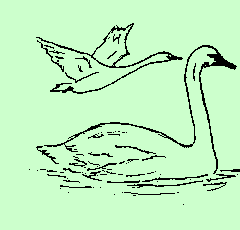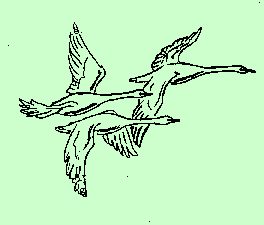|
The Trumpeter Swan


 The Trumpeter Swan (Olor buccinator), the largest of the
swans (58 to 72 inches), and the largest of our wildfowl, was widespread
in early America. The remains of prehistoric villages in Ohio and Illinois
revealed that bones of trumpeter swans were used as tools and were cut up
for beads. The Indians used the plumage of these magnificent white birds
as symbols and for decoration.
The Trumpeter Swan (Olor buccinator), the largest of the
swans (58 to 72 inches), and the largest of our wildfowl, was widespread
in early America. The remains of prehistoric villages in Ohio and Illinois
revealed that bones of trumpeter swans were used as tools and were cut up
for beads. The Indians used the plumage of these magnificent white birds
as symbols and for decoration.

 As the white man settled the wilderness, these swans, because of their
beauty and size, became tempting targets. The beautiful plumage was sold
on the London market for adornment, and to make powder puffs and down
quilts. Between 1853 and 1877 the Hudson Bay Company handled some 17,000
swan skins, many of which were trumpeters. By Audubon's day they were very
scarce in the East. This bird artist preferred trumpeter quills for drawing
fine details. "The quills", he wrote, "were so hard, and yet so elastic,
that the best steel pen of the present day might have blushed, if it could,
to be compared with them."
As the white man settled the wilderness, these swans, because of their
beauty and size, became tempting targets. The beautiful plumage was sold
on the London market for adornment, and to make powder puffs and down
quilts. Between 1853 and 1877 the Hudson Bay Company handled some 17,000
swan skins, many of which were trumpeters. By Audubon's day they were very
scarce in the East. This bird artist preferred trumpeter quills for drawing
fine details. "The quills", he wrote, "were so hard, and yet so elastic,
that the best steel pen of the present day might have blushed, if it could,
to be compared with them."

 By 1900 the trumpeter swan was nearly extinct. Edward Howe Forbush, the
eminent ornithologist lamented: "The trumpeter has succumbed to incessant
persecution in all parts of its range, and its total extinction is now only
a matter of years. ... The large size of this bird, and its conspicuousness,
have served as in the case of the Whooping Crane, to make it a shining mark,
and the trumpetings that were once heard over the breadth of a great
continent, as the long converging lines drove on from zone to zone, will
soon be heard no more."
By 1900 the trumpeter swan was nearly extinct. Edward Howe Forbush, the
eminent ornithologist lamented: "The trumpeter has succumbed to incessant
persecution in all parts of its range, and its total extinction is now only
a matter of years. ... The large size of this bird, and its conspicuousness,
have served as in the case of the Whooping Crane, to make it a shining mark,
and the trumpetings that were once heard over the breadth of a great
continent, as the long converging lines drove on from zone to zone, will
soon be heard no more."

 In 1918 the Migratory Bird Treaty outlawed the hunting of trumpeters, almost
too late. A few pairs were discovered nesting in Yellowstone National Park
in 1919, which was encouraging, but as late as 1933 only sixty six of these
great swans were reported in the United States. A turning point in the
trumpeter's struggle for survival came in 1935. "The Red Rock Lakes
National Wildlife Refuge was created in the isolated Centennial Valley of
southwest Montana. Today several hundred trumpeters nest in the sloughs,
marshes and sedge meadows of this mountain region. The trumpeters of this
valley do not migrate even when the winter temperatures are as low as
forty degrees below zero, for the valley's spring fed waters are warmed by
the same subterranean heat that makes Old Faithful boil up in Yellowstone
National Park. The U. S. Fish and Wildlife Service puts out approximately
1000 bushels of grain each year to tide the birds through the bitter
winter months. The swans tread the shallows rapidly to churn aquatic plants
free from the bottom, then turn bottoms up to eat the loosened vegetation."
In 1918 the Migratory Bird Treaty outlawed the hunting of trumpeters, almost
too late. A few pairs were discovered nesting in Yellowstone National Park
in 1919, which was encouraging, but as late as 1933 only sixty six of these
great swans were reported in the United States. A turning point in the
trumpeter's struggle for survival came in 1935. "The Red Rock Lakes
National Wildlife Refuge was created in the isolated Centennial Valley of
southwest Montana. Today several hundred trumpeters nest in the sloughs,
marshes and sedge meadows of this mountain region. The trumpeters of this
valley do not migrate even when the winter temperatures are as low as
forty degrees below zero, for the valley's spring fed waters are warmed by
the same subterranean heat that makes Old Faithful boil up in Yellowstone
National Park. The U. S. Fish and Wildlife Service puts out approximately
1000 bushels of grain each year to tide the birds through the bitter
winter months. The swans tread the shallows rapidly to churn aquatic plants
free from the bottom, then turn bottoms up to eat the loosened vegetation."

 Trumpeters pair off at about three years of age, but don't begin breeding
until they reach five years. They probably mate for life. On quivering wings
a cob (male) and pen (female) tread toward each other on the water in
courtship display. The birds grab loads of vegetation in their bills and
drop them on the nesting site, often atop a beaver lodge or an elevated
knoll near water. The finished home may be as much as five feet in diameter.
The three to seven dull white eggs hatch in about five weeks. The newly
hatched cygnets have either gray or white down. They grow rapidly, and by
October are ready to fly with their parents.
Trumpeters pair off at about three years of age, but don't begin breeding
until they reach five years. They probably mate for life. On quivering wings
a cob (male) and pen (female) tread toward each other on the water in
courtship display. The birds grab loads of vegetation in their bills and
drop them on the nesting site, often atop a beaver lodge or an elevated
knoll near water. The finished home may be as much as five feet in diameter.
The three to seven dull white eggs hatch in about five weeks. The newly
hatched cygnets have either gray or white down. They grow rapidly, and by
October are ready to fly with their parents.

 The white trumpeters are much larger than the whistling swans (48 to 55
inches), and have a heavier all black bill. Their voices are much louder,
lower pitched, and more bugle-like than that of whistling swans.
The white trumpeters are much larger than the whistling swans (48 to 55
inches), and have a heavier all black bill. Their voices are much louder,
lower pitched, and more bugle-like than that of whistling swans.

 (Editor's Note: In Minnesota OUT-OF-DOORS, December 1969, it is reported
that after the 1968 census the trumpeters were removed from the government's
list of rare and endangered wildlife. That year the biologists of the
Department of Interior's Bureau of Sport Fisheries and Wildlife, reported
907 trumpeters in the contiguous United States, and estimated over four
thousand in the total population.)
(Editor's Note: In Minnesota OUT-OF-DOORS, December 1969, it is reported
that after the 1968 census the trumpeters were removed from the government's
list of rare and endangered wildlife. That year the biologists of the
Department of Interior's Bureau of Sport Fisheries and Wildlife, reported
907 trumpeters in the contiguous United States, and estimated over four
thousand in the total population.)

 -- by Marie L. Atkinson -- by Marie L. Atkinson

REFERENCES:
Field Guide to Western Birds
Roger Tory Peterson

National Geographic Magazine

Audubon Nature Encyclopedia, Vol. 10

Bird Nests of the West
Richard Headstrom
|
|

